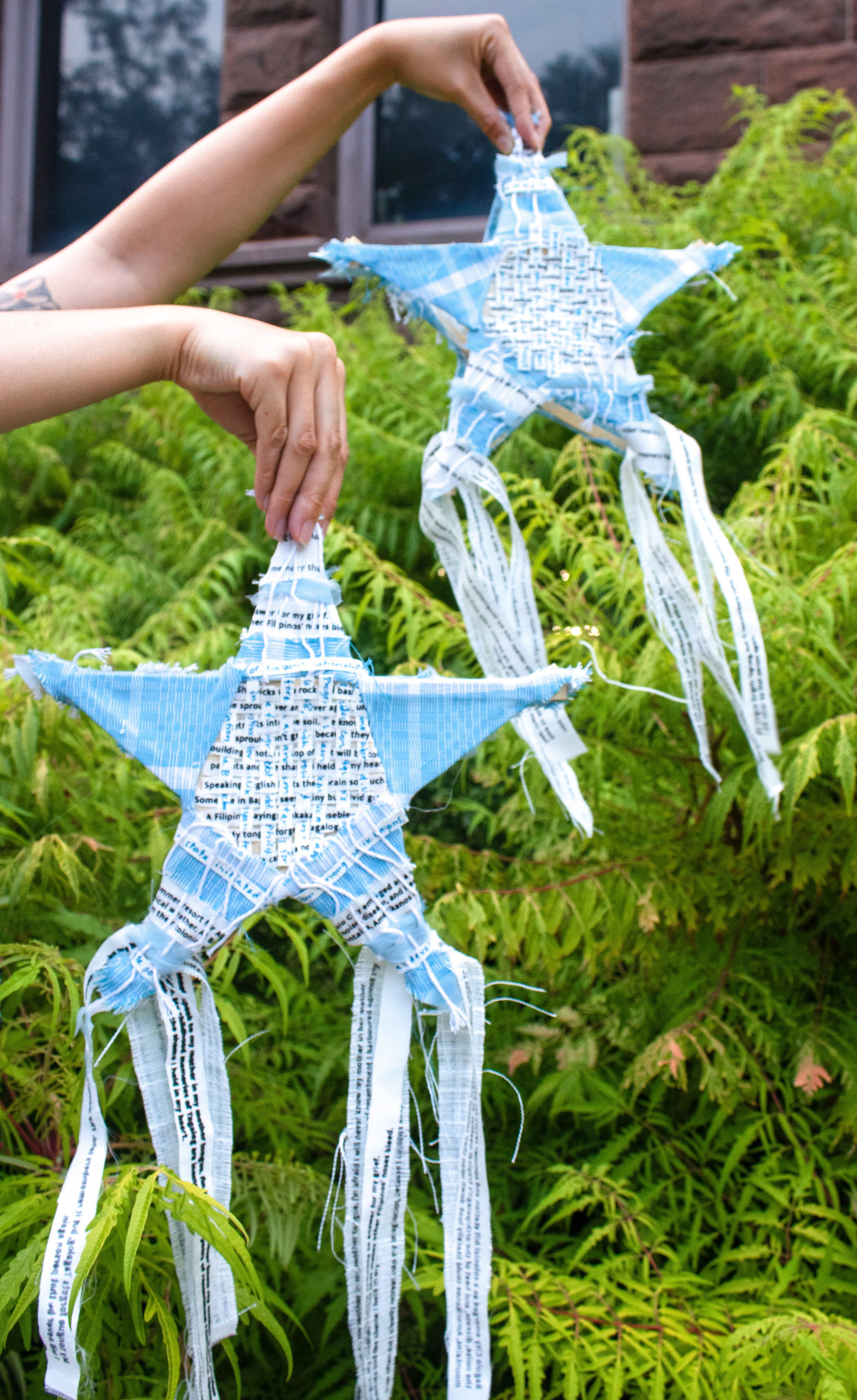BAGYO: Text(ile) Parols 2023
Exhibited with BAGYO: Terno Prototype at Patuloy ang Laban (The Fight Continues): Legacies of Filipino Activism in Toronto by Kamalayan Konsciousness and Myseum of Toronto.
The parol is a Philippine lantern that families display on their windows and doors every Christmas season. Its origins can be traced to the Spanish colonial period in the Philippines, when early parols were rectangular or oblong-shaped homemade creations constructed out of bamboo, papel de japon (Japanese paper), and a candle for illumination. The five-pointed star became the most popular parol shape during the American colonial period.
Parol artisans today use a range of natural material, like capiz shells, woven dried palm leaves, coconut husks, abaca, crab shells, and corn husks, as well as recycled material like plastic cups, bags, bottles, drinking straws, spoons, and forks. The parols that are created with these natural and recycled resources are a testament to the culture of creative, sustainable craftsmanship in the Philippines.
Following this creative lineage, I constructed and designed parol prototypes using a mix of different retaso (scrap fabric) secured onto a three-dimensional star-shaped bamboo frame that I repurposed from a set of blinds.
A geometric pattern of pastel, sky-blue squares and rectangles on Binakol scrap fabric woven by artisan Mang Abel Ti Abra in Ilocos Norte, Philippines, finds itself next to terno (butterfly sleeve) silk scrap fabric sewn by Filipino-Canadian fashion designer Jillian Joy. This retaso encounter happens first on my loom, where I weave my own story in between Indigenous and diasporic Philippine text(ile) knowleges.
“Do you speak Tagalog?”
“No, I don’t speak Tagalog.”
“Why not? Your parents should have taught you.”
Through this text(ile) work, I confront my struggles of imperfection as an ‘emerging’ artist as well as the grief I hold in my heart about losing my first language to English. I screen printed a thrifted white curtain with text from a story I wrote about leaving and returning to my hometown Baguio. Emulating rainfall, these story scrap fabrics cascade down toward the earth in long strands from the star-shaped, sky-coloured lanterns.
My hometown is the city of Baguio. Fourteen-hundred metres above sea level in the Cordillera mountain range, Baguio was known as Kafagway when the Ibaloy Indigenous people inhabited the region. A few early Spanish colonizers documented the grazing land and pine trees, but it wasn’t until American occupation that the Ibaloy people were kicked out, and Baguio City emerged as a colonial hill station and summer resort for Americans and Filipino elites to escape the noise, disease, and heat of the archipelago’s tropical weather. At Baguio’s commanding height in the mountains, Amerikanos could literally look down upon their colonial subjects.
I come from American occupation.
After cutting my story text(ile) strips from paragraphs into single phrase lines, I intersected them with quotes handwritten on secondhand handmade paper from the books Queering the Global Filipina Body: Contested Nationalisms in the Filipina/o Diaspora by Gina K. Velasco and Pangayaw and Decolonizing Resistance: Anarchism in the Philippines by Bas Umali. This weave intertwining my screen printed story with handwritten academic research makes up the centre of both parols, as a means to deconstruct exclusionary ideas about what counts as legitimate knowledge. It also expresses the fundamental intersection between lived experiences and political mobilization.
My childhood memories of Tagalog are inextricable from years of resentment I harboured against my parents and the shame I held tightly in my heart. How often did I silently retreat into my imagination, because I couldn’t keep asking for translations over and over again? How to describe watching my parents make each other laugh in punchlines I could never translate and then criticize me in English?
BAGYO is a first draft collage that connects not only transnational reworked scrap fabric, but it also mixes together a range of artmaking skills I taught myself (sewing and parol-making) and skills I learned from other artists: weaving (Maria Patricia Abuel), creative writing (Justine Abigail Yu), and screen printing (Jackie Lee). As a text(ile) artist, I strive to engage with fabric in a way that encourages learning and sharing communal knowledge.
I wanted to learn these artmaking skills as a means to nurture my suppressed creative impulse and to heal from years of ingrained perfectionism, burn-out, and imposter syndrome. This emotional turmoil is inseparable from my learned immigrant anxieties of survival in a nation-state that demands assimilation and erasure, leaving no space for mistakes.
There’s a saying that Filipinos use: “nakaka-nosebleed!” Speaking English hurts their brain so much that it causes a nosebleed. I want someone to answer for my grief. For the hole blasted in my throat that makes other Filipinos' noses bleed. Why must I hurl myself at Tagalog like an outsider instead of gently breathing its air growing up?
BAGYO celebrates mistakes and the rough first steps of a new journey in a playful fashion. Through a weaving process of deconstruction / reconstruction, it is a text(ile) manifestation of my efforts to find comfort in the discomfort of cacophonous fragments and feelings of incompleteness—a tumultuous, stormy process not unlike diaspora migration.



